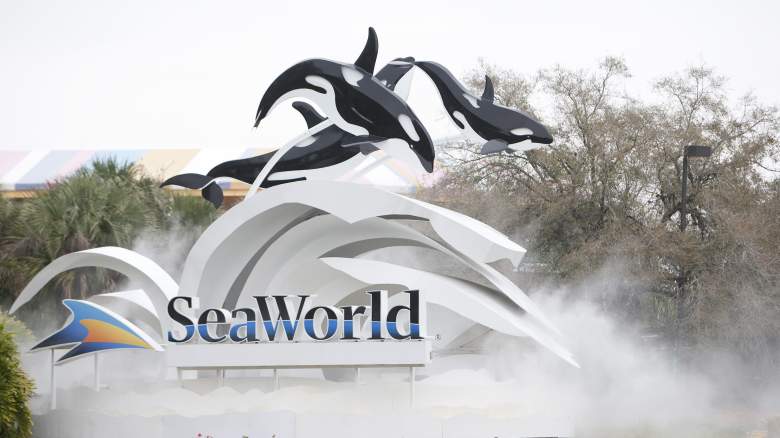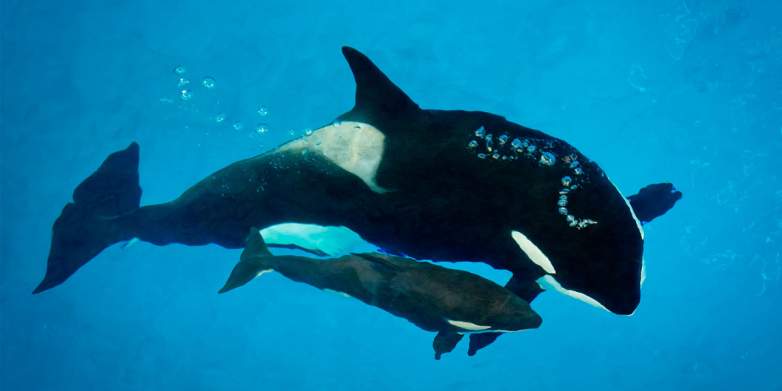
Kyara, the last orca born in captivity at SeaWorld, has died. The three-month-old killer whale calf was living at SeaWorld San Antonio and suffered a series of health issues before her death on July 24.
“The dedicated team of veterinarians and care staff spent the last three days providing critical care for Kyara, but despite their best efforts, her health continued to decline and she passed away earlier today,” the company said in a statement. “She was surrounded by the dedicated teams that cared for her over the last three months and fought tirelessly for her over the last several days.”
Kyara was conceived before SeaWorld announced last year that it will no longer be breeding killer whales. The company has been under fire for years from animal rights groups, accused of breeding orcas for the sole purpose of entertainment. The criticism reached new heights when the 2013 documentary film Blackfish, which focused on the treatment of an orca named Tilikum, was released.
Here’s what you need to know about Kyara’s death and the future of SeaWorld’s orca programs.
1. Kyara’s Exact Cause of Death Is Unknown, but She Likely Died of Pneumonia

SeaWorldCares.comKyara.
SeaWorld said Kyara’s trainers “fought tirelessly” to help her survive a series of health issues that became progressively worse in the week before her death. Although her exact cause of death has yet to be determined, the company Said in a statement that she had an “infection, likely pneumonia.”
The official cause of death won’t be determined until a post-mortem exam is complete, SeaWorld said. They explained that she was under 24-hour care at SeaWorld San Antonio, with an expert veterinary staff using antimicrobials to treat her.
Kyara was separated from her mother, Takara. The company said this was done out of concern for Kyara’s health.
“Our primary concern was the health of Kyara,” the statement reads. “The expert veterinary and animal care teams made the decision to bring Kyara to the husbandry pool at the Animal Hospital to ensure she received the necessary hydration and treatment. Additionally, Kyara had not been receiving the daily nutrition that she needed, so the teams supplemented that nutrition through hand-feeding multiple times each day.”
2. Bacterial Pneumonia Is the Most Common Cause of Death for Orcas in Captivity
According to Ocra Network, bacterial pneumonia is the most common cause of death for orcas and dolphins held in captivity.
In fact, Tilikum, the orca who killed trainer Dawn Brancheau, died in January from bacterial penumonia, SeaWorld said in February.
SeaWorld of Hurt, a PETA site, reports that nine orcas have died from pneumonia in SeaWorld captivity since 1971.
SeaWorld said it will make the necropsy, the term for the autopsy of an animal, of Kyara public once it is completed. The organization insisted that Kyara didn’t get pneumonia from being in captivity.
“No, Kyara’s pneumonia has been identified as the most common cause of mortality and illness in whales in dolphins, both in the wild and in zoological facilities,” the company said. It also stated that no other orcas at San Antonio are “showing any signs of illness, but they continued to be monitored and cared for by SeaWorld’s expert veterinary and animal care teams.”
3. Kyara Was the Last Orca Born in SeaWorld Captivity
In 2016, SeaWorld finally announced that it is no longer breeding orcas. Kyara, who was born in April, was conceived before the announcement was made. However, SeaWorld did not release their orcas in the wild because they wouldn’t survive in the wild. SeaWorld said it hasn’t collected an orca from the wild in four decades.
“SeaWorld has introduced more than 400 million guests to orcas, and we are proud of our part in contributing to the human understanding of these animals,” Joel Manby, SeaWorld president, said last year. “We’ve helped make orcas among the most beloved marine mammals on the planet. As society’s understanding of orcas continues to change, SeaWorld is changing with it. By making this the last generation of orcas in our care and reimagining how guests will experience these beautiful animals, we are fulfilling our mission of providing visitors to our parks with experiences that matter.”
“Kyara had a tremendous impact on each of her care staff, not to mention all of the guests that had the chance to see her,” trainer Julie Sigman said in a statement. “From late nights to early morning, rain or shine, we dedicate our lives to these animals, and this loss will be felt throughout the entire SeaWorld family.”
When Kyara was born, PETA called for her and Takara to be moved to a sanctuary where Takara “and her fifth calf would be free from the confinement of a tiny concrete tank and, perhaps someday, even be reunited with her children and her mother, who are currently dispersed among all three of SeaWorld’s U.S. parks and at the notorious Loro Parque in Spain.”
But SeaWorld defended Kyara being born in captivity, saying this was the last chance to see study the development of an orca in ways researchers can’t in the wild.
4. SeaWorld Still Has 22 Killer Whales at its Habitats
SeaWorld still has 22 orcas left at at its part habitats, notes NBC News. With Kyara’s death, the youngest is now Amaya, who was born in December 2014.
The remaining whales will live at SeaWorld park habitats for the rest of their lives there, but the public programs have changed. In SeaWorld San Diego, the Shamu shows ended. They will continue in Orlando and San Antonio until 2019.
SeaWorld plans to introduce “natural orca encounters” for guests, instead of the famous Shamu shows, where whales performed ticks. According to the company, these programs will focus on educating guests at redesigned show pools and viewing areas. The shows began in San Diego in May 2017.
5. SeaWorld Is Still Trying to Dig Out of the Attendance Drop After ‘Blackfish’
Although SeaWorld has made efforts to respond to the critiques in Blackfish, the company’s profits and attendance numbers are still reeling from the effects of the 2013 film.
In August 2015, Time Magazine reported that it saw an 84 percent drop in net second-quarter income compared to the same period in 2014. Attendance dropped 100,000 at its parks compared to the same period the year before.
“We realize we have much work ahead of us to recover more of our attendance base, increase revenue and improve our performance as returning to historical performance levels will take time and investment,” Manby Said at the time.
The numbers continue to be bleak. SeaWorld reported that during the first quarter of 2017, total revenue fell from $220.2 million in the first quarter of 2016 to $186.4 million. The one bright spot was season pass sales revenues climbing 6 percent compared to the year before.
SeaWorld said its attendance dropped 14.9 percent (or around 491,000 guests) in the first quarter of the year, compared to the same period of 2016. They blamed the attendance drop “primarily due to a shift in the timing of the Easter holiday into the second quarter of 2017, which also impacted the timing of spring break for a number of schools in the company’s key source markets.”